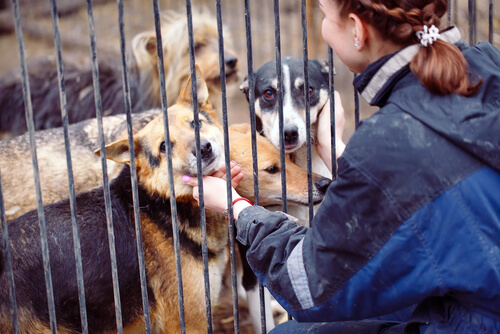Controlling the Birth Rates of Dogs


Written and verified by the lawyer Francisco María García
Every day there are more packs of strays dogs roaming the streets. It’s a growing problem that can be diminished by controlling the birth rate of dogs. This control begins with dog owners. Neutering your dog is a good way to keep them from reproducing uncontrollably. Likewise, it’s good for their health.
Why is it important to control dog birth rates?
Controlling dog birth rates is probably the only way to make an impact on the number of strays walking around towns and cities.
The main goal is to stop people from abandoning these poor animals or to at least bring the numbers as low as possible. Neutering is a great way of doing this, and it’s good for their health and life expectancy.
There are a few different strategies that need to be applied to bring the number of stray dogs down. Apart from neutering strays, raising awareness and take more control over our neighborhoods and communities.

One of these strategies is to register and identify dogs. Another important strategy is to educate people on how to be responsible dog owners and even have it pass in legislation.
Strategies for controlling the birth rates of dogs
Neutering
Without a doubt, neutering your dog is the most effective way to control their birth rates. When you do it at an early stage of life, you’re preventing the future abandonment of puppies, and doing something positive for your pet’s health.
It’s best to do it when a dog reaches 12 months old, or 18 at the latest if it’s a bigger breed. It’s a simple surgical procedure–dogs recover from it in no time.
Benefits of early neutering your dog at an early stage of life is a reduction in aggressiveness, prevention of breast cancer, ovarian cysts, and prostate issues, and an increased life expectancy, among other things.
Raising awareness about responsible pet ownership
A lot of owners abandon their dogs when they get tired of them. They want the dog to play with them and give them company, but when they realize that it’s also a responsibility and has needs, they end up abandoning it.
Pet abandonment is tragic, and more people are doing it with dogs. That’s why we need to have awareness campaigns about responsible pet ownership.

It’s important to tell people about all the responsibilities that come with owning a dog. You have to keep their vaccines up to date, de-worm them, and take them to the vet for check-ups. That’s also without mentioning all their daily hygiene needs.
Promoting stray dog adoption
Another strategy is to get more people to adopt strays. Neutering and adoption are the perfect formula for quickly bringing down the numbers of stray dogs. Of course, it’s still important to make sure the new owner understands all their responsibilities.
Registering dogs
You also need to register and identify every dog. If one is missing, it will be much easier to find its owner and return it to them. You can either do temporary or permanent identifications. Temporary identifications are things like collars or ear badges. Permanent identifications are things like tattoos, microchips, etc…
Chemical sterilization or birth control
You can also do less invasive things like chemical sterilization or birth control. One of the most common strategies is to isolate females when they’re in heat. Just remember, these methods don’t do anything positive for a dog’s health.
Controlling the birth rates of dogs is a major part of reducing the number of stray dogs on the street. There need to be more sterilization days, awareness campaigns about responsible pet ownership, and adoption of strays.
Every day there are more packs of strays dogs roaming the streets. It’s a growing problem that can be diminished by controlling the birth rate of dogs. This control begins with dog owners. Neutering your dog is a good way to keep them from reproducing uncontrollably. Likewise, it’s good for their health.
Why is it important to control dog birth rates?
Controlling dog birth rates is probably the only way to make an impact on the number of strays walking around towns and cities.
The main goal is to stop people from abandoning these poor animals or to at least bring the numbers as low as possible. Neutering is a great way of doing this, and it’s good for their health and life expectancy.
There are a few different strategies that need to be applied to bring the number of stray dogs down. Apart from neutering strays, raising awareness and take more control over our neighborhoods and communities.

One of these strategies is to register and identify dogs. Another important strategy is to educate people on how to be responsible dog owners and even have it pass in legislation.
Strategies for controlling the birth rates of dogs
Neutering
Without a doubt, neutering your dog is the most effective way to control their birth rates. When you do it at an early stage of life, you’re preventing the future abandonment of puppies, and doing something positive for your pet’s health.
It’s best to do it when a dog reaches 12 months old, or 18 at the latest if it’s a bigger breed. It’s a simple surgical procedure–dogs recover from it in no time.
Benefits of early neutering your dog at an early stage of life is a reduction in aggressiveness, prevention of breast cancer, ovarian cysts, and prostate issues, and an increased life expectancy, among other things.
Raising awareness about responsible pet ownership
A lot of owners abandon their dogs when they get tired of them. They want the dog to play with them and give them company, but when they realize that it’s also a responsibility and has needs, they end up abandoning it.
Pet abandonment is tragic, and more people are doing it with dogs. That’s why we need to have awareness campaigns about responsible pet ownership.

It’s important to tell people about all the responsibilities that come with owning a dog. You have to keep their vaccines up to date, de-worm them, and take them to the vet for check-ups. That’s also without mentioning all their daily hygiene needs.
Promoting stray dog adoption
Another strategy is to get more people to adopt strays. Neutering and adoption are the perfect formula for quickly bringing down the numbers of stray dogs. Of course, it’s still important to make sure the new owner understands all their responsibilities.
Registering dogs
You also need to register and identify every dog. If one is missing, it will be much easier to find its owner and return it to them. You can either do temporary or permanent identifications. Temporary identifications are things like collars or ear badges. Permanent identifications are things like tattoos, microchips, etc…
Chemical sterilization or birth control
You can also do less invasive things like chemical sterilization or birth control. One of the most common strategies is to isolate females when they’re in heat. Just remember, these methods don’t do anything positive for a dog’s health.
Controlling the birth rates of dogs is a major part of reducing the number of stray dogs on the street. There need to be more sterilization days, awareness campaigns about responsible pet ownership, and adoption of strays.
This text is provided for informational purposes only and does not replace consultation with a professional. If in doubt, consult your specialist.








